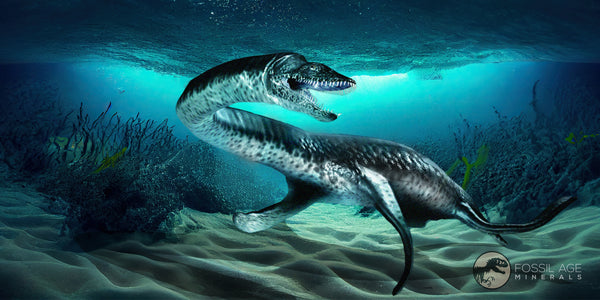1.7" Plesiosaur Zarafasaura Tooth Fossil In Matrix Cretaceous Dinosaur Era COA
Location: Khouribga, Morocco
Weight: 4.9 Ounces
Dimensions: 3.8 Inches Long, 2.3 Inches Wide, 1.1 Inches Thick (Matrix)
Tooth Dimensions: 1.7 Inches Long, 0.5 Inches Wide
Comes with a Certificate of Authenticity.
The item pictured is the one you will receive.
This is a genuine Tooth fossil.
Plesiosaur Zarafasaura
Zarafasaura Oceanis is a member of the Elasmosauridae family. Its genus name combines Zarafa, an Arabic term meaning ‘giraffe,’ with the Greek word Saurus, meaning ‘lizard.’ The species name translates to ‘daughter of the sea’ in Latin. This species was first identified in 2011 by paleontologist Dr. Peggy Vincent and her team at the National Museum of Natural History in Paris, based on partial skull fossils discovered in Morocco. Zarafasaura Oceanis measured about 23 feet (7 meters) in length and existed roughly 72 to 66 million years ago.
Plesiosaurus is just one genus of many that form the family Plesiosauriae. In artistic depictions, many artists do not draw a distinction between these types of Plesiosaurs. Additionally, much of the art depicting the Plesiosaurus is heavily influenced by Cryptozoid mythology surrounding the Loch Ness Monster and other similar creatures.
Existed from 228 million years ago to 61.6 million years ago
Lived in a marine environment
Was a carnivore
938 different specimens have been found by paleontologists.

Please be aware of the nature of fossils:
Being buried under the ground for millions of years under tons of pressure tends to be rough. No fossil comes out of the ground whole and perfect. Most fossils have undergone some restoration, while others are altered by man simply to enhance their presentation in different ways. The workers in Morocco do a very professional job of unearthing and preserving these natural treasures; however, commonly, natural cracks are visible on the surface. These are part of the natural beauty of the fossil and are not considered defects.

















